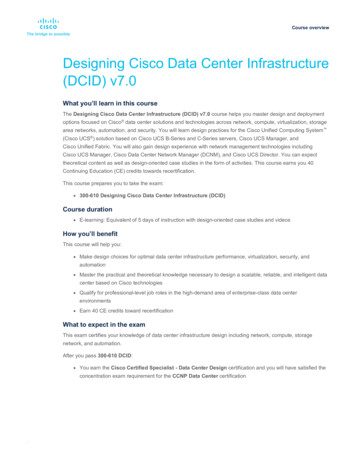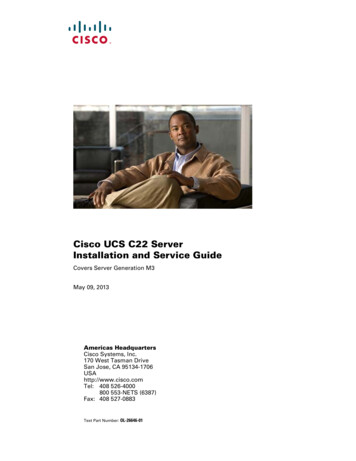
Transcription
Course overviewDesigning Cisco Data Center Infrastructure(DCID) v7.0What you’ll learn in this courseThe Designing Cisco Data Center Infrastructure (DCID) v7.0 course helps you master design and deploymentoptions focused on Cisco data center solutions and technologies across network, compute, virtualization, storagearea networks, automation, and security. You will learn design practices for the Cisco Unified Computing System (Cisco UCS ) solution based on Cisco UCS B-Series and C-Series servers, Cisco UCS Manager, andCisco Unified Fabric. You will also gain design experience with network management technologies includingCisco UCS Manager, Cisco Data Center Network Manager (DCNM), and Cisco UCS Director. You can expecttheoretical content as well as design-oriented case studies in the form of activities. This course earns you 40Continuing Education (CE) credits towards recertification.This course prepares you to take the exam: 300-610 Designing Cisco Data Center Infrastructure (DCID)Course duration E-learning: Equivalent of 5 days of instruction with design-oriented case studies and videosHow you’ll benefitThis course will help you: Make design choices for optimal data center infrastructure performance, virtualization, security, andautomation Master the practical and theoretical knowledge necessary to design a scalable, reliable, and intelligent datacenter based on Cisco technologies Qualify for professional-level job roles in the high-demand area of enterprise-class data centerenvironments Earn 40 CE credits toward recertificationWhat to expect in the examThis exam certifies your knowledge of data center infrastructure design including network, compute, storagenetwork, and automation.After you pass 300-610 DCID: You earn the Cisco Certified Specialist - Data Center Design certification and you will have satisfied theconcentration exam requirement for the CCNP Data Center certification.
Course overviewWho should enrollIT professionals with five to eight years of experience in these roles: Data center engineers Network designers Network administrators Network engineers Systems engineers Consulting systems engineers Technical solutions architects Server administrators Network managers Cisco integrators or partnersHow to enrollE-learning To buy a single e-learning license, visit the Cisco Learning Network Store. For more than one license, or a learning library subscription, contact us at learning-bdm@cisco.com.Technology areas Data centerCourse detailsObjectivesAfter taking this course, you should be able to: Describe the Layer 2 and Layer 3 forwarding options and protocols used in a data center Describe the rack design options, traffic patterns, and data center switching layer access, aggregation,and core Describe the Cisco Overlay Transport Virtualization (OTV) technology that is used to interconnectdata centers Describe Locator/ID separation protocol Design a solution that uses Virtual Extensible LAN (VXLAN) for traffic forwarding Describe hardware redundancy options; how to virtualize the network, compute, and storage functions; andvirtual networking in the data center Describe solutions that use fabric extenders and compare Cisco Adapter Fabric Extender (FEX) with singleroot input/output virtualization (SR-IOV) Describe security threats and solutions in the data center Describe advanced data center security technologies and best practices Describe device management and orchestration in the data center Describe the storage options for compute function and different Redundant Array of Independent Disks(RAID) levels from a high-availability and performance perspective Describe Fibre Channel concepts, topologies, architecture, and industry termsPage 2 of 8
Course overview Describe Fibre Channel over Ethernet (FCoE) Describe security options in the storage network Describe management and automation options for storage networking infrastructure Describe Cisco UCS servers and use cases for various Cisco UCS platforms Explain the connectivity options for fabric interconnects for southbound and northbound connections Describe the hyper converged solution and integrated systems Describe the system wide parameters for setting up a Cisco UCS domain Describe role-based access control (RBAC) and integration with directory servers to control access rightson Cisco UCS Manager Describe the pools that may be used in service profiles or service profile templates on Cisco UCS Manager Describe the different policies in the service profile Describe the Ethernet and Fibre Channel interface policies and additional network technologies Describe the advantages of templates and the difference between initial and updated templates Describe data center automation toolsPrerequisitesBefore taking this course, you should be able to: Implement data center networking [Local Area Network (LAN) and Storage Area Network (SAN)] Describe data center storage Implement data center virtualization Implement Cisco Unified Computing System (Cisco UCS) Implement data center automation and orchestration with the focus on Cisco Application CentricInfrastructure (ACI) and Cisco UCS Director Describe products in the Cisco Data Center Nexus and Multilayer Director Switch (MDS) familiesTo fully benefit from this course, you should have completed the following courses or obtained the equivalent levelof knowledge: Understanding Cisco Data Center Foundations (DCFNDU) Implementing and Administering Cisco Networking Technologies (CCNA ) Implementing Cisco Data Center Core Technologies (DCCOR)Page 3 of 8
Course overviewOutline Describing High Availability on Layer 2 Overview of Layer 2 High-Availability Mechanisms Virtual Port Channels Cisco Fabric Path Virtual Port Channel Designing Layer 3 Connectivity First Hop Redundancy Protocols Improve Routing Protocol Performance and Security Enhance Layer 3 Scalability and Robustness Designing Data Center Topologies Data Center Traffic Flows Cabling Challenges Access Layer Aggregation Layer Core Layer Spine-and-Leaf Topology Redundancy Options Designing Data Center Interconnects with Cisco OTV Cisco OTV Overview Cisco OTV Control and Data Planes Failure Isolation Cisco OTV Features Optimize Cisco OTV Evaluate Cisco OTV Describing Locator/ID Separation Protocol Locator/ID Separation Protocol Location Identifier Separation Protocol (LISP) Virtual Machine (VM) Mobility LISP Extended Subnet Mode (ESM) Multihop Mobility LISP VPN Virtualization Describing VXLAN Overlay Networks Describe VXLAN Benefits over VLAN Layer 2 and Layer 3 VXLAN Overlay Multiprotocol Border Gateway Protocol (MP-BGP) Ethernet VPN (EVPN) Control Plane Overview VXLAN Data PlanePage 4 of 8
Course overview Describing Hardware and Device Virtualization Hardware-Based High Availability Device Virtualization Cisco UCS Hardware Virtualization Server Virtualization SAN Virtualization N-Port ID Virtualization Describing Cisco FEX Options Cisco Adapter FEX Access Layer with Cisco FEX Cisco FEX Topologies Virtualization-Aware Networking Single Root I/O Virtualization Cisco FEX Evaluation Describing Basic Data Center Security Threat Mitigation Attack and Countermeasure Examples Secure the Management Plane Protect the Control Plane RBAC and Authentication, Authorization, and Accounting (AAA) Describing Advanced Data Center Security Cisco TrustSec in Cisco Secure Enclaves Architecture Cisco TrustSec Operation Firewalling Positioning the Firewall Within Data Center Networks Cisco Firepower Portfolio Firewall Virtualization Design for Threat Mitigation Describing Management and Orchestration Network and License Management Cisco UCS Manager Cisco UCS Director Cisco Intersight Cisco DCNM Overview Describing Storage and RAID Options Position DAS in Storage Technologies Network-Attached Storage Fibre Channel, FCoE, and Internet Small Computer System Interface (iSCSI) Evaluate Storage TechnologiesPage 5 of 8
Course overview Describing Fibre Channel Concepts Fibre Channel Connections, Layers, and Addresses Fibre Channel Communication Virtualization in Fibre Channel SAN Describing Fibre Channel Topologies SAN Parameterization SAN Design Options Choosing a Fibre Channel Design Solution Describing FCoE FCoE Protocol Characteristics FCoE Communication Data Center Bridging FCoE Initialization Protocol FCoE Design Options Describing Storage Security Common SAN Security Features Zones SAN Security Enhancements Cryptography in SAN Describing SAN Management and Orchestration Cisco DCNM for SAN Cisco DCNM Analytics and Streaming Telemetry Cisco UCS Director in the SAN Cisco UCS Director Workflows Describing Cisco UCS Servers and Use Cases Cisco UCS C-Series Servers Fabric Interconnects and Blade Chassis Cisco UCS B-Series Server Adapter Cards Stateless Computing Cisco UCS Mini Describing Fabric Interconnect Connectivity Use of Fabric Interconnect Interfaces VLANs and VSANs in a Cisco UCS Domain Southbound Connections Northbound Connections Disjoint Layer 2 Networks Fabric Interconnect High Availability and RedundancyPage 6 of 8
Course overview Describing Hyper converged and Integrated Systems Hyper converged and Integrated Systems Overview Cisco HyperFlex Solution Cisco HyperFlex Scalability and Robustness Cisco HyperFlex Clusters Cluster Capacity and Multiple Clusters on One Cisco UCS Domain External Storage and Graphical Processing Units on Cisco HyperFlex Cisco HyperFlex Positioning Describing Cisco UCS Manager System wide Parameters Cisco UCS Setup and Management Cisco UCS Traffic Management Describing Cisco UCS RBAC Roles and Privileges Organizations in Cisco UCS Manager Locales and Effective Rights Authentication, Authorization, and Accounting Two-Factor Authentication Describing Pools for Service Profiles Global and Local Pools Universally Unique Identifier (UUID) Suffix and Media Access Control (MAC) Address Pools World Wide Name (WWN) Pools Server and iSCSI Initiator IP Pools Describing Policies for Service Profiles Global vs. Local Policies Storage and Basic Input/Output System (BIOS) Policies Boot and Scrub Policies Intelligent Platform Management Interface (IPMI) and Maintenance Policies Describing Network-Specific Adapters and Policies LAN Connectivity Controls SAN Connectivity Controls Virtual Access Layer Connectivity Enhancements Describing Templates in Cisco UCS Manager Cisco UCS Templates Service Profile Templates Network TemplatesPage 7 of 8
Course overview Designing Data Center Automation Model-Driven Programmability Cisco NX-API Overview Programmability Using Python Cisco Ansible Module Use the Puppet AgentCourse content is dynamic and subject to change without notice. 2021 Cisco and/or its affiliates. All rights reserved.DCID v7.0C22-742709-0501/21Page 8 of 8
Course overview Designing Cisco Data Center Infrastructure (DCID) v7.0 . What you'll learn in this course . The Designing Cisco Data Center Infrastructure (DCID) v7.0 course helps you master design and deployment options focused on Cisco data center solutions and technologies across network, compute, virtualization, storage area networks, automation, and security.










